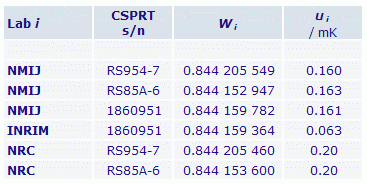

CCT-K2, CCT-K2.1, CCT-K2.3, CCT-K2.4 and CCT-K2.5
Comparison of Capsule-type Standard Platinum Resistance Thermometers (CSPRT)
MEASURAND : Resistance Ratio, W, at nominal temperature
NOMINAL TEMPERATURE : Near 13.8033 K, the triple point of spin-equilibrated hydrogen on the International Temperature Scale of 1990 (ITS-90)
Click on the stamp to view the graph of equivalence
CCT-K2, CCT-K2.1, CCT-K2.3 and CCT-K2.5
Comparison of Capsule-type Standard Platinum Resistance Thermometers (CSPRT)
MEASURAND : Resistance Ratio, W, at nominal temperature
NOMINAL TEMPERATURE : Near 17.035 K, a defining fixed point on the International Temperature Scale of 1990 (ITS-90)
Click on the stamp to view the graph of equivalence
CCT-K2, CCT-K2.1, CCT-K2.3 and CCT-K2.5
Comparison of Capsule-type Standard Platinum Resistance Thermometers (CSPRT)
MEASURAND : Resistance Ratio, W, at nominal temperature
NOMINAL TEMPERATURE : Near 20.271 K, a defining fixed point on the International Temperature Scale of 1990 (ITS-90)
Click on the stamp to view the graph of equivalence
CCT-K2, CCT-K2.1, CCT-K2.3, CCT-K2.4 and CCT-K2.5
Comparison of Capsule-type Standard Platinum Resistance Thermometers (CSPRT)
MEASURAND : Resistance Ratio, W, at nominal temperature
NOMINAL TEMPERATURE : Near 24.5561 K, the triple point of neon on the International Temperature Scale of 1990 (ITS-90)
Click on the stamp to view the graph of equivalence
CCT-K2, CCT-K2.1, CCT-K2.3, CCT-K2.4 and CCT-K2.5
Comparison of Capsule-type Standard Platinum Resistance Thermometers (CSPRT)
MEASURAND : Resistance Ratio, W, at nominal temperature
NOMINAL TEMPERATURE : Near 54.3584 K, the triple point of oxygen on the International Temperature Scale of 1990 (ITS-90)
Click on the stamp to view the graph of equivalence
CCT-K2, CCT-K2.1, CCT-K2.3, CCT-K2.4 and CCT-K2.5
Comparison of Capsule-type Standard Platinum Resistance Thermometers (CSPRT)
MEASURAND : Resistance Ratio, W, at nominal temperature
NOMINAL TEMPERATURE : Near 83.8058 K, the triple point of argon on the International Temperature Scale of 1990 (ITS-90)
Click on the stamp to view the graph of equivalence
CCT-K2, CCT-K2.1, CCT-K2.3, CCT-K2.4 and CCT-K2.5
Comparison of Capsule-type Standard Platinum Resistance Thermometers (CSPRT)
MEASURAND : Resistance Ratio, W, at nominal temperature
NOMINAL TEMPERATURE : Near 234.3156 K, the triple point of mercury on the International Temperature Scale of 1990 (ITS-90)
Click on the stamp to view the graph of equivalence
CCT-K2, CCT-K2.1, CCT-K2.3, CCT-K2.4 and CCT-K2.5
Comparison of Capsule-type Standard Platinum Resistance Thermometers (CSPRT)
MEASURAND : Resistance Ratio, W, at nominal temperature
NOMINAL TEMPERATURE : Near 13.8033 K, the triple point of spin-equilibrated hydrogen on the International Temperature Scale of 1990 (ITS-90)
Measurements were performed in two separate groups of thermometers: Group A and Group B.
Degrees of equivalence relative to the CCT-K2 key comparison reference values, Di and Ui (at 95 % confidence level) expressed in mK
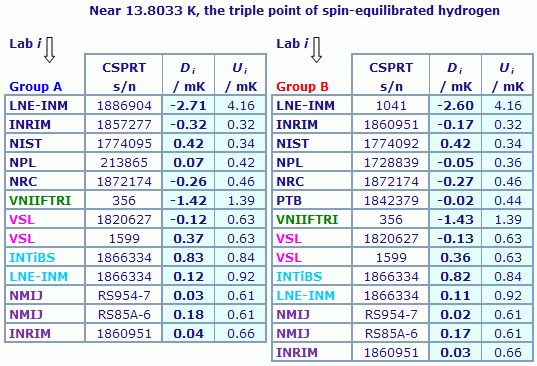
In blue: participants in CCT-K2
VNIIFTRI participant in CCT-K2.1
VSL participant in CCT-K2.3
INTiBS and LNE-INM participants in CCT-K2.4
NMIJ and INRIM participants in CCT-K2.5
Results are presented under A4 printable format in Summary Results (PDF file).
CCT-K2, CCT-K2.1, CCT-K2.3 and CCT-K2.5
Comparison of Capsule-type Standard Platinum Resistance Thermometers (CSPRT)
MEASURAND : Resistance Ratio, W, at nominal temperature
NOMINAL TEMPERATURE : Near 17.035 K, a defining fixed point on the International Temperature Scale of 1990 (ITS-90)
Measurements were performed in two separate groups of thermometers: Group A and Group B.
Degrees of equivalence relative to the CCT-K2 key comparison reference values, Di and Ui (at 95 % confidence level) expressed in mK
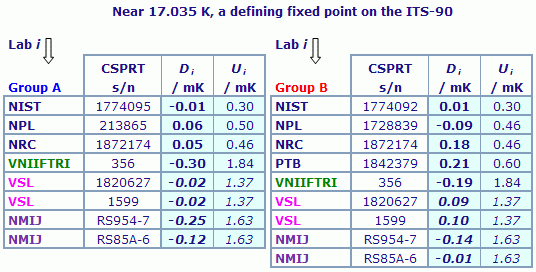
In blue: participants in CCT-K2
VNIIFTRI participant in CCT-K2.1
VSL participant in CCT-K2.3
NMIJ participant in CCT-K2.5
Italics: values that are not, strictly speaking, traveable to CCT-K2 (see the relevant Final Reports)
Results are presented under A4 printable format in Summary Results (PDF file).
CCT-K2, CCT-K2.1, CCT-K2.3 and CCT-K2.5
Comparison of Capsule-type Standard Platinum Resistance Thermometers (CSPRT)
MEASURAND : Resistance Ratio, W, at nominal temperature
NOMINAL TEMPERATURE : Near 20.271 K, a defining fixed point on the International Temperature Scale of 1990 (ITS-90)
Measurements were performed in two separate groups of thermometers: Group A and Group B.
Degrees of equivalence relative to the CCT-K2 key comparison reference values, Di and Ui (at 95 % confidence level) expressed in mK
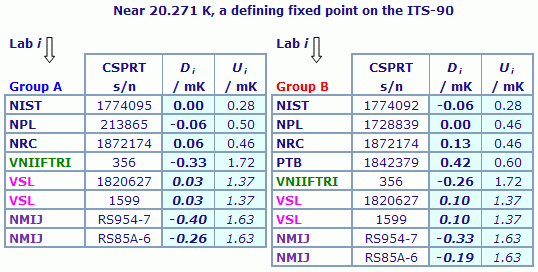
In blue: participants in CCT-K2
VNIIFTRI participant in CCT-K2.1
VSL participant in CCT-K2.3
NMIJ participant in CCT-K2.5
Italics: values that are not, strictly speaking, traveable to CCT-K2 (see the relevant Final Reports)
Results are presented under A4 printable format in Summary Results (PDF file).
CCT-K2, CCT-K2.1, CCT-K2.3, CCT-K2.4 and CCT-K2.5
Comparison of Capsule-type Standard Platinum Resistance Thermometers (CSPRT)
MEASURAND : Resistance Ratio, W, at nominal temperature
NOMINAL TEMPERATURE : Near 24.5561 K, the triple point of neon the International Temperature Scale of 1990 (ITS-90)
Measurements were performed in two separate groups of thermometers: Group A and Group B.
Degrees of equivalence relative to the CCT-K2 key comparison reference values, Di and Ui (at 95 % confidence level) expressed in mK
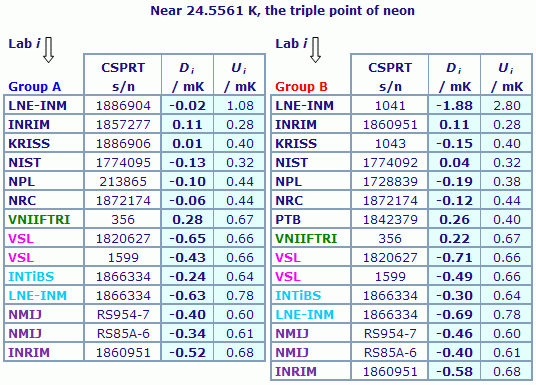
In blue: participants in CCT-K2
VNIIFTRI participant in CCT-K2.1
VSL participant in CCT-K2.3
INTiBS and LNE-INM participants in CCT-K2.4
NMIJ and INRIM participants in CCT-K2.5
Results are presented under A4 printable format in Summary Results (PDF file).
CCT-K2, CCT-K2.1, CCT-K2.3, CCT-K2.4 and CCT-K2.5
Comparison of Capsule-type Standard Platinum Resistance Thermometers (CSPRT)
MEASURAND : Resistance Ratio, W, at nominal temperature
NOMINAL TEMPERATURE : Near 54.3584 K, the triple point of oxygen on the International Temperature Scale of 1990 (ITS-90)
Measurements were performed in two separate groups of thermometers: Group A and Group B.
Degrees of equivalence relative to the CCT-K2 key comparison reference values, Di and Ui (at 95 % confidence level) expressed in mK
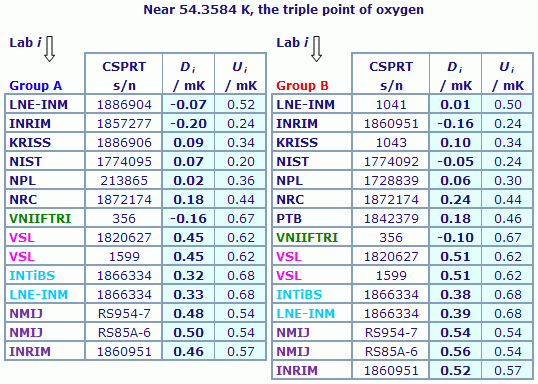
In blue: participants in CCT-K2
VNIIFTRI participant in CCT-K2.1
VSL participant in CCT-K2.3
INTiBS and LNE-INM participants in CCT-K2.4
NMIJ and INRIM participants in CCT-K2.5
Results are presented under A4 printable format in Summary Results (PDF file).
CCT-K2, CCT-K2.1, CCT-K2.3, CCT-K2.4 and CCT-K2.5
Comparison of Capsule-type Standard Platinum Resistance Thermometers (CSPRT)
MEASURAND : Resistance Ratio, W, at nominal temperature
NOMINAL TEMPERATURE : Near 83.8058 K, the triple point of argon on the International Temperature Scale of 1990 (ITS-90)
Measurements were performed in two separate groups of thermometers: Group A and Group B.
Degrees of equivalence relative to the CCT-K2 key comparison reference values, Di and Ui (at 95 % confidence level) expressed in mK
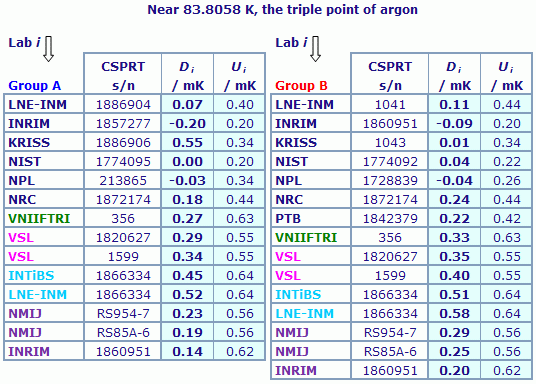
In blue: participants in CCT-K2
VNIIFTRI participant in CCT-K2.1
VSL participant in CCT-K2.3
INTiBS and LNE-INM participants in CCT-K2.4
NMIJ and INRIM participants in CCT-K2.5
Results are presented under A4 printable format in Summary Results (PDF file).
CCT-K2, CCT-K2.1, CCT-K2.3, CCT-K2.4 and CCT-K2.5
Comparison of Capsule-type Standard Platinum Resistance Thermometers (CSPRT)
MEASURAND : Resistance Ratio, W, at nominal temperature
NOMINAL TEMPERATURE : Near 234.3156 K, the triple point of mercury on the International Temperature Scale of 1990 (ITS-90)
Measurements were performed in two separate groups of thermometers: Group A and Group B.
Degrees of equivalence relative to the CCT-K2 key comparison reference values, Di and Ui (at 95 % confidence level) expressed in mK
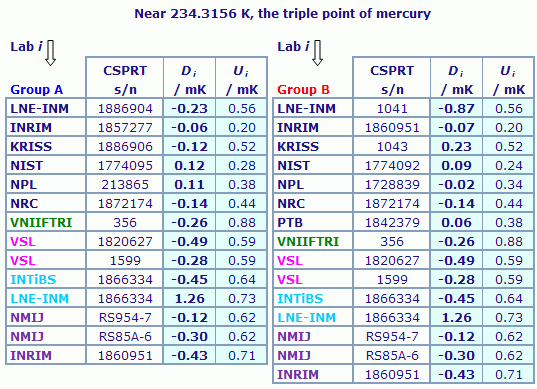
In blue: participants in CCT-K2
VNIIFTRI participant in CCT-K2.1
VSL participant in CCT-K2.3
INTiBS and LNE-INM participants in CCT-K2.4
NMIJ and INRIM participants in CCT-K2.5
Results are presented under A4 printable format in Summary Results (PDF file).
| Metrology area, Sub-field | Thermometry, Standard Platinum Resistance Thermometers |
| Description | Realizations of the ITS-90 from 13.8 K to 273.16 K |
| Time of measurements | 2006 |
| Status | Approved for equivalence |
| Final Reports of the comparisons | |
| Measurand | Temperature: 13.8 K to 273.16 K |
| Transfer device | Capsule-type standard platinum resistance thermometers |
| Comparison type | Key Comparison |
| Consultative Committee | CCT (Consultative Committee for Thermometry) |
| Conducted by | CCT (Consultative Committee for Thermometry) |
| Comments | This bilateral key comparison between the NRC and the NMi-VSL is a follow up of key comparison CCT-K2 Results published on 01 June 2012 CCT-K2.1, CCT-K2.3, CCT-K2.4 and CCT-K2.5 results are linked to those of CCT-K2 Realizations of the ITS-90 from 13.8 K to 273.16 K
|
| Pilot institute |
NRC
National Research Council Canada |
| Contact person | Ken HILL +1 613 998 6077 |
This page proposes print-out on A4 paper (portrait) of the comparison details (best printed out using a black and white printer).
Please, select items to be printed out, then click on "OK" :
CCT-K2, CCT-K2.1, CCT-K2.3, CCT-K2.4 and CCT-K2.5
Comparison of Capsule-type Standard Platinum Resistance Thermometers (CSPRT)
MEASURAND : Resistance Ratio, W, at nominal temperature
NOMINAL TEMPERATURE : Near 13.8033 K, the triple point of spin-equilibrated hydrogen on the International Temperature Scale of 1990 (ITS-90)
| Key comparison reference value: there is no single reference value for this comparison. The two measurement runs (Group A and Group B) are evaluated separately. Resistance ratios are used with calibration equations for each thermometer to obtain temperature Ti. For each group, the key comparison reference temperature, TR, is the weighted average temperature calculated using the experimental variances to set the weights. They have zero uncertainty by definition. |
| The degree of equivalence of each laboratory with respect to the reference value is given by a pair of terms: Di = (Ti - TR) and Ui, its expanded uncertainty (at 95% confidence level), both expressed in mK. |
| When required, the degree of equivalence between two laboratories is given by a pair of terms: Dij = Di - Dj = (Ti - TR) - (Tj - TR ) and Uij, its expanded uncertainty (95%), both expressed in mK. |
The VNIIFTRI data obtained from CCT-K2.1, the VSL data obtained from CCT-K2.3, the INTiBS and LNE-INM data obtained from CCT-K2.4, and the NMIJ and INRIM data obtained in CCT-K2.5 are linked to CCT-K2 results via NRC, as may be seen on page 4, 5 and 6 of the CCT-K2.1 Final Report, and in Sections 3 of the CCT-K2.3 Final Report, the CCT-K2.4 Final Report, and the CCT-K2.5 Final Report.
| In CCT-K2 Group A and Group B thermometers have been analyzed separately. Degrees of equivalence of linked key comparisons are expressed with respect to the CCT-K2 key comparison reference values for Groups A and B. |
| No pair-wise degrees of equivalence are reported here. |
CCT-K2, CCT-K2.1, CCT-K2.3 and CCT-K2.5
Comparison of Capsule-type Standard Platinum Resistance Thermometers (CSPRT)
MEASURAND : Resistance Ratio, W, at nominal temperature
NOMINAL TEMPERATURE : Near 17.035 K, a defining fixed point on the International Temperature Scale of 1990 (ITS-90)
| Key comparison reference value: there is no single reference value for this comparison. The two measurement runs (Group A and Group B) are evaluated separately. Resistance ratios are used with calibration equations for each thermometer to obtain temperature Ti. For each group, the key comparison reference temperature, TR, is the weighted average temperature calculated using the experimental variances to set the weights. They have zero uncertainty by definition. |
| The degree of equivalence of each laboratory with respect to the reference value is given by a pair of terms: Di = (Ti - TR) and Ui, its expanded uncertainty (at 95% confidence level), both expressed in mK. |
| When required, the degree of equivalence between two laboratories is given by a pair of terms: Dij = Di - Dj = (Ti - TR) - (Tj - TR ) and Uij, its expanded uncertainty (95%), both expressed in mK. |
The VNIIFTRI data obtained from CCT-K2.1, the VSL data obtained from CCT-K2.3, and the NMIJ data obtained in CCT-K2.5 are linked to CCT-K2 results via NRC, as may be seen on page 4, 5 and 6 of the CCT-K2.1 Final Report, and in Sections 3 of the CCT-K2.3 Final Report and the CCT-K2.5 Final Report.
| In CCT-K2 Group A and Group B thermometers have been analyzed separately. Degrees of equivalence of linked key comparisons are expressed with respect to the CCT-K2 key comparison reference values for Groups A and B. |
| No pair-wise degrees of equivalence are reported here. |
CCT-K2, CCT-K2.1, CCT-K2.3 and CCT-K2.5
Comparison of Capsule-type Standard Platinum Resistance Thermometers (CSPRT)
MEASURAND : Resistance Ratio, W, at nominal temperature
NOMINAL TEMPERATURE : Near 20.271 K, a defining fixed point on the International Temperature Scale of 1990 (ITS-90)
| Key comparison reference value: there is no single reference value for this comparison. The two measurement runs (Group A and Group B) are evaluated separately. Resistance ratios are used with calibration equations for each thermometer to obtain temperature Ti. For each group, the key comparison reference temperature, TR, is the weighted average temperature calculated using the experimental variances to set the weights. They have zero uncertainty by definition. |
| The degree of equivalence of each laboratory with respect to the reference value is given by a pair of terms: Di = (Ti - TR) and Ui, its expanded uncertainty (at 95% confidence level), both expressed in mK. |
| When required, the degree of equivalence between two laboratories is given by a pair of terms: Dij = Di - Dj = (Ti - TR) - (Tj - TR ) and Uij, its expanded uncertainty (95%), both expressed in mK. |
The VNIIFTRI data obtained from CCT-K2.1, the VSL data obtained from CCT-K2.3, and the NMIJ data obtained in CCT-K2.5 are linked to CCT-K2 results via NRC, as may be seen on page 4, 5 and 6 of the CCT-K2.1 Final Report, and in Sections 3 of the CCT-K2.3 Final Report and the CCT-K2.5 Final Report.
| In CCT-K2 Group A and Group B thermometers have been analyzed separately. Degrees of equivalence of linked key comparisons are expressed with respect to the CCT-K2 key comparison reference values for Groups A and B. |
| No pair-wise degrees of equivalence are reported here. |
CCT-K2, CCT-K2.1, CCT-K2.3, CCT-K2.4 and CCT-K2.5
Comparison of Capsule-type Standard Platinum Resistance Thermometers (CSPRT)
MEASURAND : Resistance Ratio, W, at nominal temperature
NOMINAL TEMPERATURE : Near 24.5561 K, the triple point of neon on the International Temperature Scale of 1990 (ITS-90)
| Key comparison reference value: there is no single reference value for this comparison. The two measurement runs (Group A and Group B) are evaluated separately. Resistance ratios are used with calibration equations for each thermometer to obtain temperature Ti. For each group, the key comparison reference temperature, TR, is the weighted average temperature calculated using the experimental variances to set the weights. They have zero uncertainty by definition. |
| The degree of equivalence of each laboratory with respect to the reference value is given by a pair of terms: Di = (Ti - TR) and Ui, its expanded uncertainty (at 95% confidence level), both expressed in mK. |
| When required, the degree of equivalence between two laboratories is given by a pair of terms: Dij = Di - Dj = (Ti - TR) - (Tj - TR ) and Uij, its expanded uncertainty (95%), both expressed in mK. |
The VNIIFTRI data obtained from CCT-K2.1, the VSL data obtained from CCT-K2.3, the INTiBS and LNE-INM data obtained from CCT-K2.4, and the NMIJ and INRIM data obtained in CCT-K2.5 are linked to CCT-K2 results via NRC, as may be seen on page 4, 5 and 6 of the CCT-K2.1 Final Report, and in Sections 3 of the CCT-K2.3 Final Report, the CCT-K2.4 Final Report, and the CCT-K2.5 Final Report.
| In CCT-K2 Group A and Group B thermometers have been analyzed separately. Degrees of equivalence of linked key comparisons are expressed with respect to the CCT-K2 key comparison reference values for Groups A and B. |
| No pair-wise degrees of equivalence are reported here. |
CCT-K2, CCT-K2.1, CCT-K2.3, CCT-K2.4 and CCT-K2.5
Comparison of Capsule-type Standard Platinum Resistance Thermometers (CSPRT)
MEASURAND : Resistance Ratio, W, at nominal temperature
NOMINAL TEMPERATURE : Near 54.3584 K, the triple point of oxygen on the International Temperature Scale of 1990 (ITS-90)
| Key comparison reference value: there is no single reference value for this comparison. The two measurement runs (Group A and Group B) are evaluated separately. Resistance ratios are used with calibration equations for each thermometer to obtain temperature Ti. For each group, the key comparison reference temperature, TR, is the weighted average temperature calculated using the experimental variances to set the weights. They have zero uncertainty by definition. |
| The degree of equivalence of each laboratory with respect to the reference value is given by a pair of terms: Di = (Ti - TR) and Ui, its expanded uncertainty (at 95% confidence level), both expressed in mK. |
| When required, the degree of equivalence between two laboratories is given by a pair of terms: Dij = Di - Dj = (Ti - TR) - (Tj - TR ) and Uij, its expanded uncertainty (95%), both expressed in mK. |
The VNIIFTRI data obtained from CCT-K2.1, the VSL data obtained from CCT-K2.3, the INTiBS and LNE-INM data obtained from CCT-K2.4, and the NMIJ and INRIM data obtained in CCT-K2.5 are linked to CCT-K2 results via NRC, as may be seen on page 4, 5 and 6 of the CCT-K2.1 Final Report, and in Sections 3 of the CCT-K2.3 Final Report, the CCT-K2.4 Final Report, and the CCT-K2.5 Final Report.
| In CCT-K2 Group A and Group B thermometers have been analyzed separately. Degrees of equivalence of linked key comparisons are expressed with respect to the CCT-K2 key comparison reference values for Groups A and B. |
| No pair-wise degrees of equivalence are reported here. |
CCT-K2, CCT-K2.1, CCT-K2.3, CCT-K2.4 and CCT-K2.5
Comparison of Capsule-type Standard Platinum Resistance Thermometers (CSPRT)
MEASURAND : Resistance Ratio, W, at nominal temperature
NOMINAL TEMPERATURE : Near 83.8058 K, the triple point of argon on the International Temperature Scale of 1990 (ITS-90)
| Key comparison reference value: there is no single reference value for this comparison. The two measurement runs (Group A and Group B) are evaluated separately. Resistance ratios are used with calibration equations for each thermometer to obtain temperature Ti. For each group, the key comparison reference temperature, TR, is the weighted average temperature calculated using the experimental variances to set the weights. They have zero uncertainty by definition. |
| The degree of equivalence of each laboratory with respect to the reference value is given by a pair of terms: Di = (Ti - TR) and Ui, its expanded uncertainty (at 95% confidence level), both expressed in mK. |
| When required, the degree of equivalence between two laboratories is given by a pair of terms: Dij = Di - Dj = (Ti - TR) - (Tj - TR ) and Uij, its expanded uncertainty (95%), both expressed in mK. |
The VNIIFTRI data obtained from CCT-K2.1, the VSL data obtained from CCT-K2.3, the INTiBS and LNE-INM data obtained from CCT-K2.4, and the NMIJ and INRIM data obtained in CCT-K2.5 are linked to CCT-K2 results via NRC, as may be seen on page 4, 5 and 6 of the CCT-K2.1 Final Report, and in Sections 3 of the CCT-K2.3 Final Report, the CCT-K2.4 Final Report, and the CCT-K2.5 Final Report.
| In CCT-K2 Group A and Group B thermometers have been analyzed separately. Degrees of equivalence of linked key comparisons are expressed with respect to the CCT-K2 key comparison reference values for Groups A and B. |
| No pair-wise degrees of equivalence are reported here. |
CCT-K2, CCT-K2.1, CCT-K2.3, CCT-K2.4 and CCT-K2.5
Comparison of Capsule-type Standard Platinum Resistance Thermometers (CSPRT)
MEASURAND : Resistance Ratio, W, at nominal temperature
NOMINAL TEMPERATURE : Near 234.3156 K, the triple point of mercury on the International Temperature Scale of 1990 (ITS-90)
| Key comparison reference value: there is no single reference value for this comparison. The two measurement runs (Group A and Group B) are evaluated separately. Resistance ratios are used with calibration equations for each thermometer to obtain temperature Ti. For each group, the key comparison reference temperature, TR, is the weighted average temperature calculated using the experimental variances to set the weights. They have zero uncertainty by definition. |
| The degree of equivalence of each laboratory with respect to the reference value is given by a pair of terms: Di = (Ti - TR) and Ui, its expanded uncertainty (at 95% confidence level), both expressed in mK. |
| When required, the degree of equivalence between two laboratories is given by a pair of terms: Dij = Di - Dj = (Ti - TR) - (Tj - TR ) and Uij, its expanded uncertainty (95%), both expressed in mK. |
The VNIIFTRI data obtained from CCT-K2.1, the VSL data obtained from CCT-K2.3, the INTiBS and LNE-INM data obtained from CCT-K2.4, and the NMIJ and INRIM data obtained in CCT-K2.5 are linked to CCT-K2 results via NRC, as may be seen on page 4, 5 and 6 of the CCT-K2.1 Final Report, and in Sections 3 of the CCT-K2.3 Final Report, the CCT-K2.4 Final Report, and the CCT-K2.5 Final Report.
| In CCT-K2 Group A and Group B thermometers have been analyzed separately. Degrees of equivalence of linked key comparisons are expressed with respect to the CCT-K2 key comparison reference values for Groups A and B. |
| No pair-wise degrees of equivalence are reported here. |
CCT-K2, CCT-K2.1, CCT-K2.3, CCT-K2.4 and CCT-K2.5
Comparison of Capsule-type Standard Platinum Resistance Thermometers (CSPRT)
MEASURAND : Resistance Ratio, W, at nominal temperature
NOMINAL TEMPERATURE : Near 13.8033 K, the triple point of spin-equilibrated hydrogen on the International Temperature Scale of 1990 (ITS-90)
Wi : dimensionless resistance ratio of thermometer from laboratory i
s/n : serial number of thermometer from laboratory i
ui : combined standard uncertainty of measurement made using thermometer from laboratory i
Measurements were performed in two separate groups of thermometers: Group A and Group B.
.gif)
.gif)
.gif)
.gif)
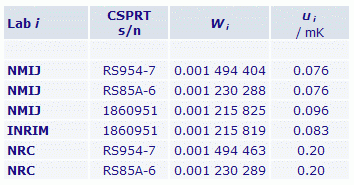
CCT-K2, CCT-K2.1, CCT-K2.3 and CCT-K2.5
Comparison of Capsule-type Standard Platinum Resistance Thermometers (CSPRT)
MEASURAND : Resistance Ratio, W, at nominal temperature
NOMINAL TEMPERATURE : Near 17.035 K, a defining fixed point on the International Temperature Scale of 1990 (ITS-90)
Wi : dimensionless resistance ratio of thermometer from laboratory i
s/n : serial number of thermometer from laboratory i
ui : combined standard uncertainty of measurement made using thermometer from laboratory i
Measurements were performed in two separate groups of thermometers: Group A and Group B.
.gif)
.gif)
.gif)
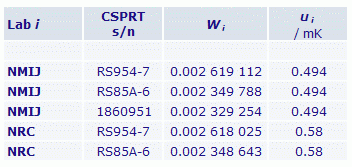
CCT-K2, CCT-K2.1, CCT-K2.3 and CCT-K2.5
Comparison of Capsule-type Standard Platinum Resistance Thermometers (CSPRT)
MEASURAND : Resistance Ratio, W, at nominal temperature
NOMINAL TEMPERATURE : Near 20.271 K, a defining fixed point on the International Temperature Scale of 1990 (ITS-90)
Wi : dimensionless resistance ratio of thermometer from laboratory i
s/n : serial number of thermometer from laboratory i
ui : combined standard uncertainty of measurement made using thermometer from laboratory i
Measurements were performed in two separate groups of thermometers: Group A and Group B.
.gif)
.gif)
.gif)
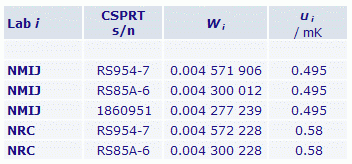
CCT-K2, CCT-K2.1, CCT-K2.3, CCT-K2.4 and CCT-K2.5
Comparison of Capsule-type Standard Platinum Resistance Thermometers (CSPRT)
MEASURAND : Resistance Ratio, W, at nominal temperature
NOMINAL TEMPERATURE : Near 24.5561 K, the triple point of neon on the International Temperature Scale of 1990 (ITS-90)
Wi : dimensionless resistance ratio of thermometer from laboratory i
s/n : serial number of thermometer from laboratory i
ui : combined standard uncertainty of measurement made using thermometer from laboratory i
Measurements were performed in two separate groups of thermometers: Group A and Group B.
.gif)
.gif)
.gif)
.gif)
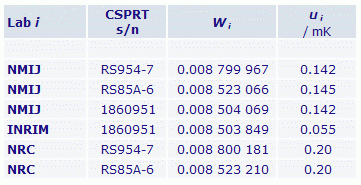
CCT-K2, CCT-K2.1, CCT-K2.3, CCT-K2.4 and CCT-K2.5
Comparison of Capsule-type Standard Platinum Resistance Thermometers (CSPRT)
MEASURAND : Resistance Ratio, W, at nominal temperature
NOMINAL TEMPERATURE : Near 54.3584 K, the triple point of oxygen on the International Temperature Scale of 1990 (ITS-90)
Wi : dimensionless resistance ratio of thermometer from laboratory i
s/n : serial number of thermometer from laboratory i
ui : combined standard uncertainty of measurement made using thermometer from laboratory i
Measurements were performed in two separate groups of thermometers: Group A and Group B.
.gif)
.gif)
.gif)
.gif)
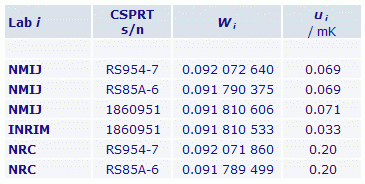
CCT-K2, CCT-K2.1, CCT-K2.3, CCT-K2.4 and CCT-K2.5
Comparison of Capsule-type Standard Platinum Resistance Thermometers (CSPRT)
MEASURAND : Resistance Ratio, W, at nominal temperature
NOMINAL TEMPERATURE : Near 83.8058 K, the triple point of argon on the International Temperature Scale of 1990 (ITS-90)
Wi : dimensionless resistance ratio of thermometer from laboratory i
s/n : serial number of thermometer from laboratory i
ui : combined standard uncertainty of measurement made using thermometer from laboratory i
Measurements were performed in two separate groups of thermometers: Group A and Group B.
.gif)
.gif)
.gif)
.gif)
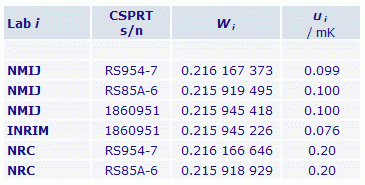
CCT-K2, CCT-K2.1, CCT-K2.3, CCT-K2.4 and CCT-K2.5
Comparison of Capsule-type Standard Platinum Resistance Thermometers (CSPRT)
MEASURAND : Resistance Ratio, W, at nominal temperature
NOMINAL TEMPERATURE : Near 234.3156 K, the triple point of mercury on the International Temperature Scale of 1990 (ITS-90)
Wi : dimensionless resistance ratio of thermometer from laboratory i
s/n : serial number of thermometer from laboratory i
ui : combined standard uncertainty of measurement made using thermometer from laboratory i
Measurements were performed in two separate groups of thermometers: Group A and Group B.
.gif)
.gif)
.gif)
.gif)
